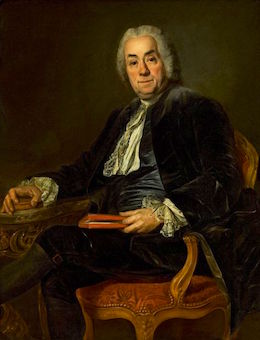Anne Claude Philippe de Tubières-Grimoard de Pastels de Lévis, comte de Caylus, marquis d’Esternay, baron de Branscac (1692-1765), generally known by the considerably shorter name of Comte de Caylus, not only had the enviable honor of having about the longest name yet of anyone discussed in this series, but also of being the grandson of a first cousin of Madame de Maintenon, known to history as the second, secret wife of Louis XIV. This in turn ensured that he and his mother had access to the very cream of French society—and the French salons, where fairy tales still remained a prime source of amusement.
Caylus flourished in this atmosphere. After fighting in the War of the Spanish Succession from 1709 to 1714, an experience that caused him to avoid the military and further wars for the rest of his life, he chose to travel through Europe, eventually making his way to Italy, Greece, and the Ottoman Empire. Here, he fell in love with antiquities and archaeology, even joining in the dig at Herculaneum, where the wealthy Emmanuel Maurice de Lorraine, Duke of Elbeuf, was busily hunting for more statues to adorn his villas. An extensive tour of what is now Turkey cemented his passion.
For most scholars, his most important work was probably the seven volume Recuiel d’Antiquities, which appeared at regular intervals from 1752-1767. But Caylus did not spend all of his time cataloguing coins (especially gold coins) and other ancient wonders. He also attended the various salons of Paris, still in operation, wrote a number of popular erotic tales, and dabbled in fairy tales and “oriental” tales—that is, tales of magic set in the Middle East, which Caylus, unlike other French writers doing the same, at least had the benefit of having seen in person.
Caylus wrote decades after Madame d’Aulnoy had pioneered the use fairy tales as subversive critiques of the court of Louis XIV, and after Charles Perrault had used those same fairy tales to uphold the court of Louis XIV—while cautioning children, and in particular girls, of the dangers there. Caylus, familiar with both, drove his own path: mocking aspects of the court of Louis XIV, but also adding in a trace of misogyny that both d’Aulnoy and Perrault had largely avoided, and just barely managing to avoid expressing some decidedly negative thoughts about the organization of the French army.
His “Princess Minute and King Floridor,” originally published in 1741, provides an excellent example of this. As the story opens, a large empire has been left to the rule of the tiny, thirteen year old Princess Minute, who has a passion for collecting knickknacks, and her fairy protector, Mirdandenne. Shortly after this, Minute dismisses a distinguished general from her court because he wore a hat laced with silver and a coat laced with gold, a negligence that she believes may be a sign of future negligence in battle. These sorts of decisions, Caylus explains, are enough to make anyone—and a kingdom—unstable.
It’s not particularly hard to connect all of this to Versailles, with its obsession with manners, fashion, and, well, delicate knickknacks—though it’s only fair to note that Caylus himself spent much of his life obsessed with and writing about delicate knickknacks, which may also account for their mention here. But Caylus here is less concerned about expenditures—a decided problem at Versailles, and one that other French salon fairy tale authors did obliquely or directly address in their tales—and more on the absurdity of basing important military matters on trivial things—and also, it seems, the problems with allowing civilians with no military experience or training to make military and personnel decisions.
Though in this particular case, the princess might have a point: given the court’s intense focus on knickknacks and trivia, it would have been prudent for the general to take extra care and—at least for this one appearance—focus on knickknacks and trivia. It sorta reminds me of the time and attention actors take over red carpet appearances: sure, it’s ludicrous, but it’s also part of their job. Negligence in one aspect might be linked to negligence elsewhere.
Or, civilian me could be completely wrong, and the former soldier scribing this might be right, and what really matters is skill in the battlefield, not what people are wearing on it, or before they reach it.
The story then shifts to the other main character, King Floridor, ruler of a tiny kingdom, whose chief advisor is a charming ant. For those with insect issues who are about to protest that no ant can ever be charming, I hear you, but this particular ant happens to be a fairy in disguise. When she hears that Minute’s kingdom is falling apart thanks to questionable leadership and about to be invaded by another king interested in marrying Minute, the fairy ant sends Floridor off to rescue Minute, without an army, but with a walnut shell, a little carving knife and a sparrow.
Minute, meanwhile, is trying to figure out if her troops should wear blue or white cockades. Ok, ok, yes, maybe the earlier criticisms do have a point. She also has failed to build fortifications or stockpile ammunition—something Caylus speaks of with enough exasperation that it seems possible he was thinking of a real life incident. With no defenses, Floridor believes the only way to save her is to take her back to his own tiny country. Once she’s safe, he can return to her country and save it from the invading king.
This part of the tale may have been inspired by any number of historical cases where a queen or an heir fled to another country, leaving others to fight on their behalf. Caylus had met people who had known the exiled Queen Henrietta Maria, for instance, while she lived in France, and he may have met Prince Charles Edward Stuart while in Rome. That is, it’s realistic—but I also couldn’t help remembering other French salon fairy tales where women led armies. Ah well.
Anyway, Minute and Floridor flee, pursued by rebels. Just as the rebel scouts come near them, Florida accidentally breaks the walnut—revealing a rather convenient army of thirty thousand men. This allows them to escape—but not for long. They soon find themselves threatened by yet another army. At this point, Minute decides to use the knife for “some trivial purpose.” We’re never told exactly what, leading me to believe that perhaps said purpose was not as trivial as Caylus wants me to believe it was), but when the knife proves to be useless as a regular knife, Minute throws it away—discovering that if it’s not particularly good at cutting ordinary things, it is good at immediately digging large holes in the ground.
Thanks to the ability to immediately create defensive fortifications with the knife, an army that can be carried in a walnut, and a sparrow which turns out to have the ability to lift mountains, Floridor is able to imprison the rebel army inside a mountain and take Minute back to the safety of his own kingdom and the approval of the magic ant. The ant does, however, take the walnut and the knife back—maybe they can only be used a certain number of times?—sending Floridor back out to war with only a letter from Minute and the sparrow. Fortunately, the sparrow is still up to moving mountains around, which allows Floridor to free the rebel army, gain its support, train its soldiers, and attack the invading king—and win.
It’s a fairy tale ending, of sorts, but not an entirely satisfying one. For one thing, it’s rather hard to tell exactly why Floridor is in love with Minute, apart from the fact that they are both in the same story. For another, most of the end of the story is focused on the importance of maintaining order and discipline in military ranks—an important point, and one that clearly nagged at Caylus, but not exactly a traditional part of the fairy tale ending. Come to think of it, for all that fairy tales often seem obsessed with soldiers and wars, I can’t remember another fairy tale quite as determined to stress the importance of military discipline versus military uniforms.
More importantly, the story ends not with the lovers rejoicing that their troubles are over, and ruling their kingdoms happily ever after, but with Minute feeling ashamed that she has done only little things with great help, while her new husband has done great things with little things. This seems more than a bit unfair: a walnut capable of concealing and carrying an entire army of thirty thousand men is small only in size, but not in consequence, and Minute, not Floridor, was the one to discover how the knife could be used, however accidentally. Of course Floridor accomplished more: he had magical items, and a mother who served as his regent until he was old enough to take the throne. She ascended her throne at thirteen—an age where a boy might well have been as obsessed with the minutiae of uniforms and gold and silver trim as she was.
Buy the Book


Finding Baba Yaga: A Short Novel in Verse
And not just unfair, but her sense of shame also seems to be a rather alarming beginning for a marriage. It’s hard not to join scholar Jack Zipes in wondering if this tale is not just mocking courtly manners and the frequent shallowness of French courts, but also mocking the very idea of a happy ending—and to a certain degree, even the concept of a fairy tale.
Indeed, for all its criticisms of courtly triviality and its insistence on a professional army, and various trappings borrowed from earlier tales, “Princess Minute and King Floridor” is more of a counter attack on the subversive fairy tales of the French salons. The aristocratic Caylus does not precisely follow the example of Charles Perrault, whose fairy tales tended to support the court of Versailles, or at least present it as an opportunity for some social climbing. And even in this tale, Caylus offers two examples of women who were able to rule tiny kingdoms, if not large ones. It’s not entirely as misogynistic as I’ve made it sound.
Still, in the context of the frequently subversive French salon fairy tales, it’s a bit jarring, coming across almost as a statement of “look, I just don’t believe you,” along with suggesting that really, all a foolish women needs is a man to organize her life and train and discipline her army. It’s notable that the two competent women of the story remain in minor roles and never leave their tiny country, while the two incompetent women play a much larger role in the story, which focuses on their deficiencies. In its attempt to counter the salon fairy tale stories, it becomes the sort of story that reminds us just why many exasperated women turned to writing subversive fairy tales in the first place.
But it also serves as an example of the richness of the fairy tale format: not just in its ability to stretch and accommodate multiple viewpoints, but in the way it almost demands responses from readers. Caylus had no shortage of material to write about, and no need to earn a living through writing. But he did feel he needed to respond to the fairy tale writers who preceded him—which says quite a bit about their power.
Mari Ness lives in central Florida.










